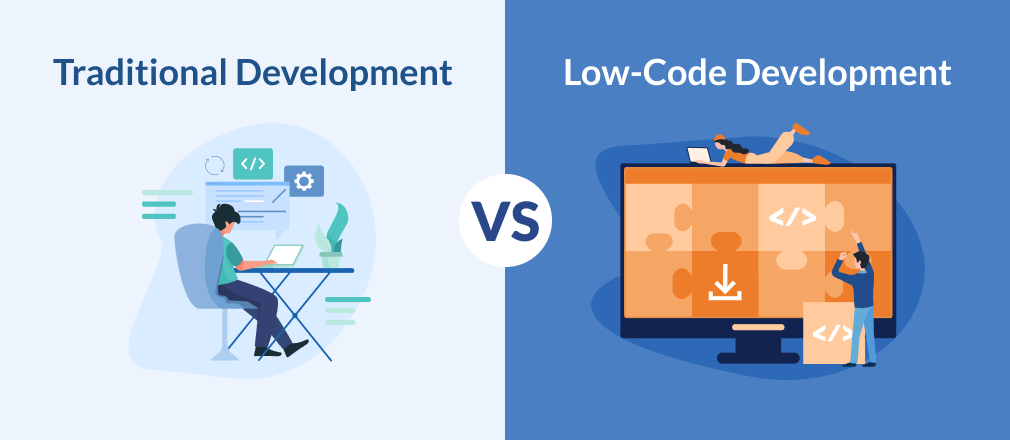Low-code development is a powerful approach to software development that allows organizations to build applications rapidly with minimal hand-coding.
It provides a visual interface and pre-built components, enabling developers to drag and drop elements and configure them using simple logic. This approach eliminates the need for extensive manual coding, reducing development time and accelerating the delivery of applications. The significance of low-code development lies in its ability to empower businesses to build faster and more efficiently.
Traditional VS Low-Code
Traditional Development:
Manual coding: Requires extensive hand-coding and programming skills.
Time-consuming: Development cycles are longer due to the need for coding from scratch.
High costs: Requires skilled developers and resources, leading to increased expenses.
Complex Costumizitaion: Customizing and modifying applications can be complex and time-consuming.
Steep learning curve: Developers need in-depth knowledge of programming languages and frameworks.
Low-Code Development:
Visual interface: Provides a drag-and-drop interface, eliminating the need for manual coding.
Rapid development: Accelerates application delivery with pre-built components and visual configurations.
Cost-effective: Reduces development costs by minimizing the need for extensive coding resources.
Easy customization: Allows for quick modifications and customization through visual tools and configurations.
Simplified learning curve: Developers can create applications with minimal coding knowledge.

Exploring the benefits
One of the benefits of low-code can considered the fact that businesses can experience accelerated development cycles, allowing them to deliver applications faster to market. The streamlined nature of low-code also leads to reduced costs, as it eliminates the need for extensive coding and programming resources. Furthermore, low-code empowers businesses with increased agility, enabling them to quickly adapt and respond to changing market demands. You can also check Kayanon Digital, which explores more into 5 top reasons why companies should go for low-code development.
Integrations and extensibility
Integrations and extensibility are key aspects of low-code development that enhance its flexibility and functionality. Low-code platforms are designed to seamlessly integrate with existing systems, enabling businesses to leverage their current technology investments. Through APIs (Application Programming Interfaces) and plugins, low-code platforms allow for easy customization and extension of functionalities. This empowers developers to connect with external services, access data from multiple sources, and incorporate third-party tools and services into their applications. With the ability to integrate and extend, low-code development offers businesses endless possibilities to create tailored solutions that perfectly align with their unique requirements and ecosystem. In the article, "Low-Code Integration and Extensibility: Is it a Myth or a Fact?", you also will understand that still these platforms don't do any magic and they still require coding expertise.
Use cases and success stories
Use cases and success stories of low-code development showcase its versatility and impact across various industries. From healthcare to finance, organizations have leveraged low-code platforms to streamline processes, improve efficiency, and deliver innovative solutions. For example, a leading healthcare provider utilized low-code development to build a patient management system, resulting in improved patient care and reduced administrative burden. Similarly, a financial institution used low-code to develop a loan processing application, accelerating loan approvals and enhancing customer experience. These real-world examples highlight the tangible benefits of low-code development in driving digital transformation and achieving business success.
Overcoming challenges
While low-code development offers numerous benefits, there are some challenges that organizations may face. These include limited customization options, potential vendor lock-in, and the need for skilled resources. However, organizations can overcome these challenges by carefully selecting a flexible and scalable low-code platform, leveraging custom coding where necessary, and investing in training and upskilling their development teams. By addressing these challenges proactively, businesses can maximize the benefits of low-code development while mitigating any potential limitations.
Security, governance considerations and future trends
Ensure a robust security framework and effective governance in your low-code development initiatives. Explore the best practices for implementing security measures, data protection, and access controls to safeguard your applications and sensitive information. Additionally, stay ahead of future trends in low-code development, such as AI integration, blockchain adoption, and enhanced automation capabilities. By prioritizing security and staying abreast of emerging trends of digital transformation, you can maximize the potential of low-code while maintaining a secure and future-proof development environment.
Conclusion
Low-code development empowers businesses to build applications rapidly with minimal hand-coding, accelerating delivery and reducing costs. It offers integration and extensibility, enabling customization and seamless integration with existing systems. Real-world use cases demonstrate its impact across industries, driving digital transformation. Overcoming challenges requires careful platform selection and skills development. Prioritizing security and staying updated on future trends ensures a successful low-code development environment. Embrace low-code for efficient software development and innovation.



